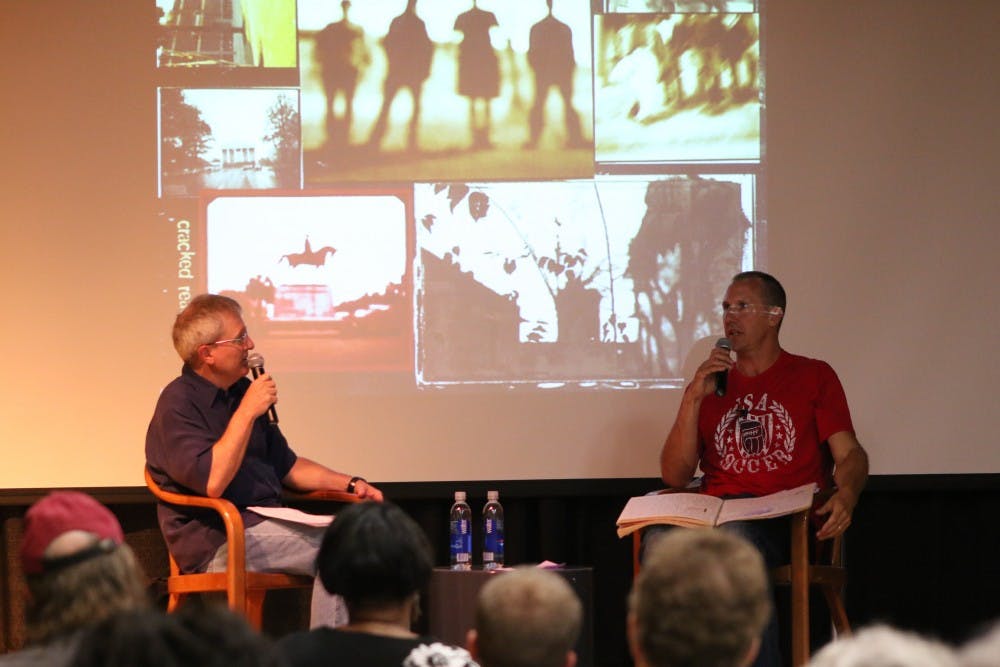Cracked Rear View, Hootie and the Blowfish’s 1994 debut, was easily the youngest subject at Jim Sonefeld and Mike Miller’s remembrance and discussion of the band’s first album at the Richland County Library on Saturday. However, age is just a number, a mantra proved true by the number of fedoras, band t-shirts and beach attire adorned by the other, older attendees.
Sonefeld, the former drummer to the band, and Miller, former editor to the music section of The State and author of a biography of the band, Hootie!, took turns discussing aspects of the band’s rise to fame from a run-of-the-mill college town band to national celebrity.
Miller recounted that his favorite part about the band was the connection that both he and they shared with his hometown. “Every night they would start their shows by announcing, ‘We are Hootie and the Blowfish from Columbia, South Carolina’ and that was always really special to me,” Miller said.
Sonefeld remembered the early struggles of the band and the doubts they had when they couldn’t catch a break. Before signing with Atlantic Records in 1993, the band drove all the way out to California just for a major label record deal to fall through. Even the ‘93 signing with Atlantic was delayed from January to the middle of the year due to an earthquake in Los Angeles.
“Maybe it’ll never happen,” Sonefeld remembered thinking. The small-scale band from Columbia set the record for checked luggage in the Columbia airport in 1993 with 28 checked bags and 16 carry-ons.
Producer Don Gehman, famous for producing the John Cougar Mellencamp hits of the ‘80s, worked with the band in California. Gehman’s goal was to turn these songs that already had some pop sensibility into something both big and unique at the same time. He was a “parser of verses” in Sonefeld’s mind.
“We were used to playing bars and having jams,” Sonefeld explained. “We became used to arranging songs together and allowing him to tinker a bit and that he did.”
The project was a big change for a group of lazy college kids used to playing in bars.
“Darius worked at a record store, Dean worked at a bar, none of us liked mornings.” Thus, it was challenging when the members had to get up at 9 a.m. every morning and work a somewhat regular work schedule for the seven weeks it took to make the album.
Afterward, the band continued playing four to five shows a week in the Southeast, waiting. Sonefeld remembered wondering, “are we huge yet or do we owe the record company money?”
Then, all of a sudden, the big day came. On August 29, 1994 Atlantic got a call from David Letterman asking the band to play The Late Show a week from Friday. The exposure from The Late Show lead to exponential increases in record sales.
Luckily, Sonefeld kept a journal throughout the entire experience of Hootie’s rise in the mid-1990s. He jokingly claimed that it was due to a lack of friends when recounting the experience on Saturday, but providing an account of it all seems prescient 20 years later. On May 25, 1995, nearly a year after it came out, Cracked Rear View hit No. 1 on Billboard charts.
Back in Columbia, Hootie had only been playing fraternity and sorority mixers. “We played St. Patrick’s day in Five Points. We would play where we could,” Sonefeld contended. “‘Time’ was written at a house on Greene Street.”
Why did this unchallenging pop music take off? Miller and Sonefeld speculated.
“The summer when it did, everything else had been heavier and gloomier. This was feel-good music,” Miller explained. “They were just pop songs for people to sing along to.” Grunge music provided the perfect backdrop for Hootie to take off.
“What worked as songwriters, there was a moment of keen naïveté,” Sonefeld said. “We were simple. Darius ability to sing the song simply was essential. Complex songs don’t make hit singles.”

